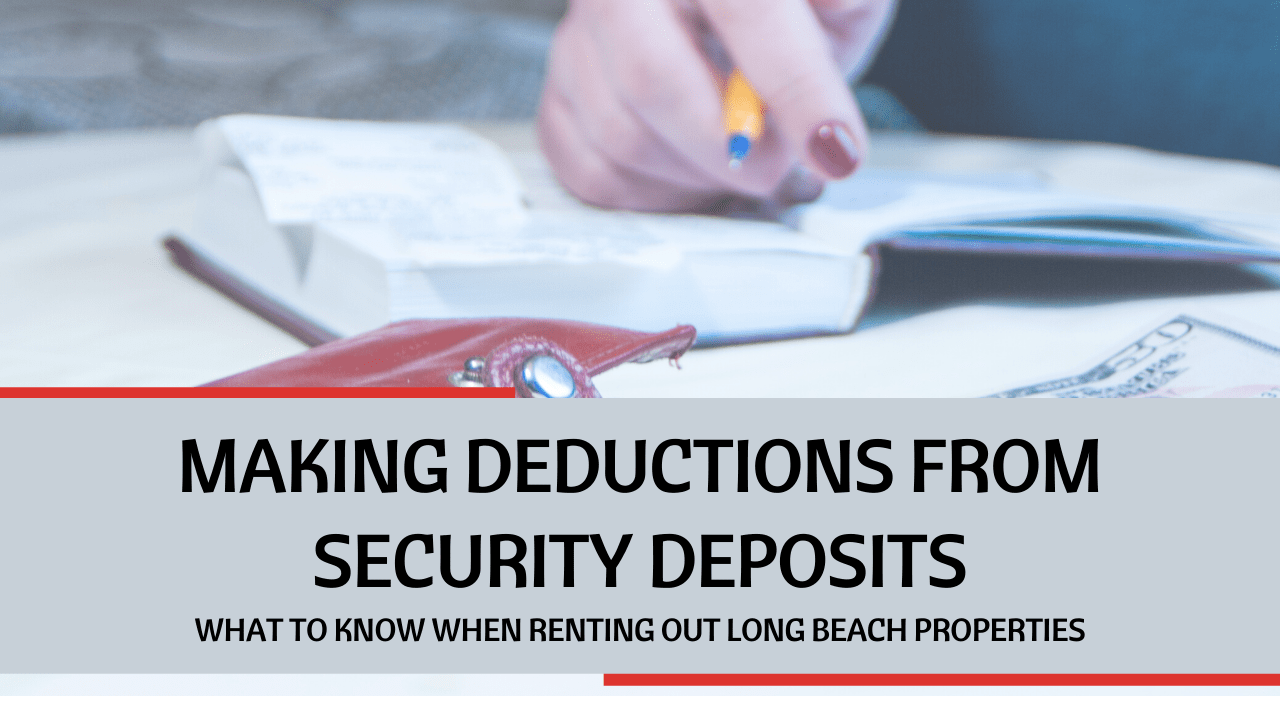
We’ve been talking a lot about
security deposits in California in this latest blog series, and today we want to focus on making deductions from your tenant’s security deposit. This is always a fine line for landlords to walk. You don’t want to find yourself covering expenses that should be the responsibility of a tenant. But, you also don’t want to trigger a conflict with your tenant which may result in a lawsuit and extra time and money spent on small claims court.
When you make a deduction from your tenant’s security deposit, it has to be legally enforceable and supported by documentation or proof.
In today’s blog, we’re looking at what you can deduct and why. We’re also explaining how to make sure you have the necessary documentation.
Start with a Detailed Move-In Inspection
Deducting from a security deposit actually starts before your tenant even moves in.
When you make deductions from a security deposit, you have to prove that the condition of the home is different than it was when the tenant moved in. You have to show that there’s more than minor wear and tear; there’s actually damage. It’s hard to do that if you haven’t effectively documented the condition of your property before a tenant moves in.
Do a thorough inspection that includes photos. Get some good video if you can as well. Be thorough. You want to document what every wall, floor, and ceiling looks like. Open drawers and closet doors. Show the locks on doors and windows and the screens and the light bulbs and air filters. It’s impossible to be too detailed.
Leave your inspection report with your tenants for a day or two after they move in so they can add anything of their own they might have found. If a door is sticking, for example, they won’t want to be charged for that at move-out, so they should indicate it on the inspection report. Have them sign the report so everyone is seen to have agreed on the condition of the property.
Keep this report throughout the tenancy and reference it at the move-out inspection, when you’ll also have the opportunity to take a detailed look at everything in your property. You’ll want to compare the two reports when you’re making decisions about the
security deposit.
If you get inside the home to conduct any maintenance inspections or make any repairs, add what you find to your move-in inspection report. If you can create an ongoing record of things that were repair, replaced, and inspected, you can have an easier time documenting your need to deduct from the security deposit.
Offer a Move-Out Inspection
In California, tenants are entitled to a move-out inspection before they vacate the unit. Most tenants don’t bother with this, but if your tenants request one, you’re legally required to provide it.
This is actually not a bad thing for landlords because you get the opportunity to walk through the property and see what kind of damage or wear and tear you’ll be dealing with once your
tenant moves out. This is also the tenant’s opportunity to get an idea of what might be deducted from the security deposit. They can take the initiative to make the repairs that are needed or they can leave it for you to do and then face the financial consequences.
Acceptable Deductions from Security Deposits
The law is very specific that you can deduct for tenant damage, but you cannot deduct for normal wear and tear. The problem is that everyone has a different definition of what qualifies as wear and tear and what counts as damage.
Wear and tear is the natural deterioration of a property, due to age and the fact that someone is living in the home. If there are scuff marks on the wall from where a couch was resting or small nail holes in the paint from where pictures were hung, that’s going to count as normal wear and tear. If there’s a large hole in the wall or a door hanging off its hinges, that’s going to count as damage.
Damage can be anything that has changed the condition of your property due to a tenant’s abuse, misuse, or neglect. It could possibly be the result of an accident, but the damage is still the tenant’s responsibility. Perhaps a window broke, for example, while the tenant was moving out. That’s going to be deducted from the deposit. Large scratches on floors, torn or stained carpets, and evidence of pet damage can all be charged to the deposit.
You can also charge for cleaning. In California, landlords are entitled to get their properties back in the same professionally clean condition that the property was rented. Include this requirement in your
lease agreement so your tenants understand the expectation. Make sure they understand that taking out the trash and wiping down the sink isn’t enough to make the house
rent-ready. You want it thoroughly cleaned, with the tubs and toilets scrubbed and the baseboards dusted. If they don’t have it professionally cleaned before they move out, you can hire cleaners to do the work and then charge the deposit.
You’re also permitted to charge for any overdue or unpaid rent. If your tenant has made only a partial payment, you can use the security deposit to cover what is owed. You can also deduct from the deposit if any keys, garage door openers, or pool passes are not returned.
Get the work done quickly when you have damage that needs to be paid for out of the deposit. This will give you plenty of time to collect the receipts and invoices so you can include them in the remaining security deposit you send back to the tenant. You’ll need to include an itemized list of what was deducted and why.
Communicating with Your Tenant
If you have had a positive and professional relationship with your tenant, there’s not a lot of risk that they’ll dispute your security deposit deductions. However, tenants who have been difficult throughout the lease period will likely be looking for any reason to dispute the charges and take you to court.

We recommend you communicate well with your tenants. If they didn’t request an inspection before moving out, they may be surprised by the deductions you’re making. Let them know why and how you made the deductions you made. If they dispute something, show them the documentation you have. Invite them to review the photographs, videos, and inspection reports. If they can easily see the damage based on the move-in and move-out inspection reports, you might save yourself from a court appearance.
It’s also important to think about what you’re willing to fight for. We always recommend that landlords be a bit more cautious and conservative when making security deposit deductions. You are certainly entitled to deduct for damage, but if you’re arguing with a tenant over a $100 deduction, remember that a court case could be lost, and then you’ll find yourself paying a lot more than that in damages.
We are here to answer any questions you may have about security deposit deductions.
Contact us at Progressive Property Management for more information.
 We’ve been talking a lot about security deposits in California in this latest blog series, and today we want to focus on making deductions from your tenant’s security deposit. This is always a fine line for landlords to walk. You don’t want to find yourself covering expenses that should be the responsibility of a tenant. But, you also don’t want to trigger a conflict with your tenant which may result in a lawsuit and extra time and money spent on small claims court.
When you make a deduction from your tenant’s security deposit, it has to be legally enforceable and supported by documentation or proof.
In today’s blog, we’re looking at what you can deduct and why. We’re also explaining how to make sure you have the necessary documentation.
We’ve been talking a lot about security deposits in California in this latest blog series, and today we want to focus on making deductions from your tenant’s security deposit. This is always a fine line for landlords to walk. You don’t want to find yourself covering expenses that should be the responsibility of a tenant. But, you also don’t want to trigger a conflict with your tenant which may result in a lawsuit and extra time and money spent on small claims court.
When you make a deduction from your tenant’s security deposit, it has to be legally enforceable and supported by documentation or proof.
In today’s blog, we’re looking at what you can deduct and why. We’re also explaining how to make sure you have the necessary documentation.
 We recommend you communicate well with your tenants. If they didn’t request an inspection before moving out, they may be surprised by the deductions you’re making. Let them know why and how you made the deductions you made. If they dispute something, show them the documentation you have. Invite them to review the photographs, videos, and inspection reports. If they can easily see the damage based on the move-in and move-out inspection reports, you might save yourself from a court appearance.
It’s also important to think about what you’re willing to fight for. We always recommend that landlords be a bit more cautious and conservative when making security deposit deductions. You are certainly entitled to deduct for damage, but if you’re arguing with a tenant over a $100 deduction, remember that a court case could be lost, and then you’ll find yourself paying a lot more than that in damages.
We are here to answer any questions you may have about security deposit deductions. Contact us at Progressive Property Management for more information.
We recommend you communicate well with your tenants. If they didn’t request an inspection before moving out, they may be surprised by the deductions you’re making. Let them know why and how you made the deductions you made. If they dispute something, show them the documentation you have. Invite them to review the photographs, videos, and inspection reports. If they can easily see the damage based on the move-in and move-out inspection reports, you might save yourself from a court appearance.
It’s also important to think about what you’re willing to fight for. We always recommend that landlords be a bit more cautious and conservative when making security deposit deductions. You are certainly entitled to deduct for damage, but if you’re arguing with a tenant over a $100 deduction, remember that a court case could be lost, and then you’ll find yourself paying a lot more than that in damages.
We are here to answer any questions you may have about security deposit deductions. Contact us at Progressive Property Management for more information.





